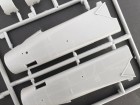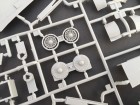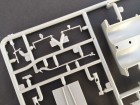
Ref: 04924
Review by Geoff Coughlin (November 2015)
Price around: £26.99 GBP
Our thanks to Revell for supplying our review sample. Revell model kits are available from all good toy and model retailers. For details visit www.revell.de/en
The Panavia Tornado is a family of twin-engine, variable-sweep wing combat aircraft, which was jointly developed and manufactured by Italy, the United Kingdom, and West Germany. There are three primary Tornado variants: the Tornado IDS (interdictor/strike) fighter-bomber, the suppression of enemy air defences Tornado ECR (electronic com-bat/reconnaissance) and the Tornado ADV (air defence variant) interceptor aircraft.
The Tornado was developed and built by Panavia Aircraft GmbH, a tri-national consortium consisting of British Aerospace (previously British Aircraft Corporation), MBB of West Ger-many, and Aeritalia of Italy. It first flew on 14 August 1974 and was introduced into service in 1979–1980. Due to its multirole nature, it was able to replace several different fleets of aircraft in the adopting air forces. The Royal Saudi Air Force (RSAF) became the only export operator of the Tornado in addition to the three original partner nations. A tri-nation train-ing and evaluation unit operating from RAF Cottesmore, the Tri-National Tornado Training Establishment, maintained a level of international co-operation beyond the production stage.
The Tornado was used by the Royal Air Force (RAF), Italian Air Force and RSAF during the 1991 Gulf War, in which the Tornado conducted many low-altitude penetrating strike mis-sions. The Tornados of various operators were also used in conflicts in the former Yugoslavia during the Bosnian War and Kosovo War, the Iraq War, Libya during the Libyan civil war, as well as smaller roles in Afghanistan, Yemen, and Syria. Including all variants, 992 aircraft were built.
At the time of writing the British government had just authorised the use of Tornado aircraft from RAF Lossiemouth, Scotland for operations over Syria (2 December 2015), together with others from RAF Marham.

We already have a build of the IDS on which this kit is based…
You may remember that James V built a GR4 from the IDS kit release with some mods here and there and you can see that model in the Revell pages in Finished Now.
Reference material – a huge modellers walk around in your SMN Photo Reference Library…
One of the best in the whole SMN Library – full internal and external coverage of a No 41 Sqn Tornado based at RAF Coningsby, Lincolnshire – happy days!
The Revell Kit
Nice to see the GR4 variant of the famous Tornado back in 1:48 scale. The Revell kit has gained much praise amongst modellers since it was released in IDS guise back in June last year. As I write these words the type is hitting the headlines as the British government has ordered precision air strikes into Syria, so it’s a slightly odd feeling as I put pen to paper.
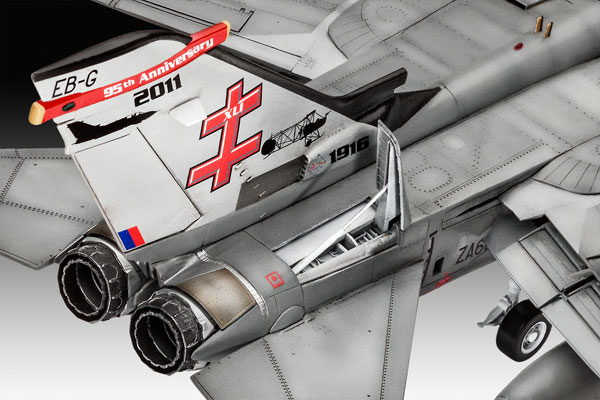

Box and contents
The Revell box artwork is usually impressive enough and that’s the case here – an image of a No 41 Sqn RAF anniversary aircraft making an attractive subject; the other a more low-vis machine from No 617 “Dambuster” Sqn.
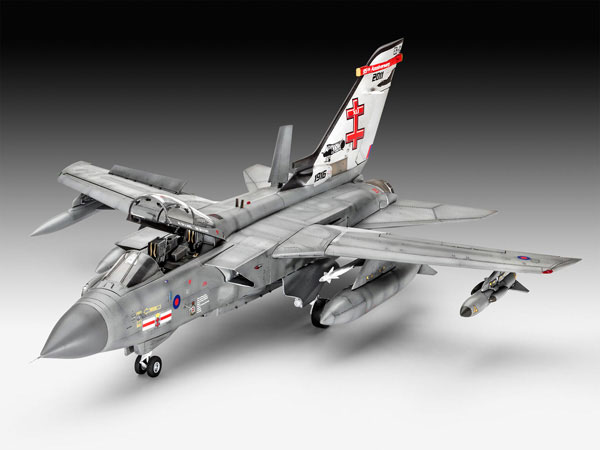
Manufacturer’s model
Taking a look at the manufacturer’s model here you can see that this model is clearly a cut above some other offerings in this scale featuring plenty of options.
Let’s go inside
Well moulded light grey sprues supplied and taking the main components first, they are well tooled, fine recessed panel line detail and good levels of detail across the board. No distor-tion on the main parts is apparent and a dry fit of the multi-part main fuselage sections sug-gests a decent fit; the initial impression is one of detail parts that will go to make up a nice representative model in 1:48 scale. No real evidence of excess flash on the parts supplied in this kit.
Cockpit and interior
Raised detail on the cockpit panels is provided as well as decals; check out that manufactur-er photo above as the cockpit looks pretty reasonable from the box. The other internals like the control columns are well detailed too as you can see from the attached photos and will add a fair bit to the eventual look. The seats look good as does the area between the crew positions.
Jet pipes
You get a decent depth tube for the exhaust jet pipes along with the detailed reheat nozzles typical of the type.



